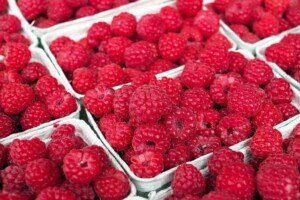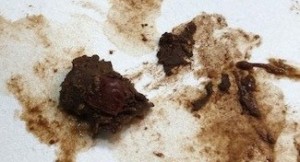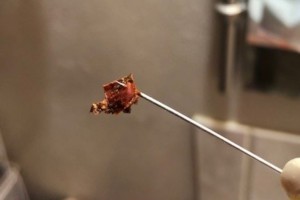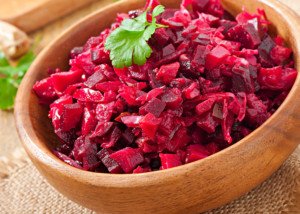
Red food clumps or particles in your poops can mimic the appearance of blood smears or clots from a disease.
Here’s how to tell whether the red you see is food vs. blood.
Undigested Food that Can Show As Red in Bowel Movements
• Tomatoes
• Pimentos
• Strawberries, raspberries
• Cherry skin
• Red grape skin
• Beets, paprika and more.
Telling the Difference: Undigested Red Food vs. Blood
Seeing what you think might be blood in your stools is scary sh*t.
After all, any pamphlet on colon cancer will list blood in bowel movements as a potential sign.
When you view your poops in the toilet, the image is skewered due to the water and limited lighting at the bottom of the bowl.
But you may spot something that looks reddish in a stool. Blood in stools can appear as dark red or maroon clots, even black.
To tell the difference, you must remove the suspect stool from the toilet and inspect it.
Inspecting Stools
• Use a spoon or scooping tool to remove from the toilet.
• Be careful, as the removal could separate fecal matter, and you might lose the suspect clump as it disperses.
• This procedure works best on very well-formed stools.
• As you bring the feces out of the water, carefully drain the water by pressing the tool to the side of the bowl. You don’t want water interfering with the inspection.
• Have a white paper plate ready to place the sample on.
• Be sure the room is very well lit.
• Have reading glasses (if your up-close vision is blurry) ready, as well as a magnifying glass.
• Other required tools are a tweezer or long sewing pin. An extended large safety pin will also do. A Q-tip swab may be needed.
Recently I looked in the toilet bowl and saw a small dark red area on a poop. I placed it on a paper plate (below).

The dark red clump is hard to see in this image, but look closely. It was more red-appearing in person.
Viewing it through reading glasses, I was not able to tell what the dark red was.
A reassuring sign was that none of the other poops had it, and there was no blood on the tissue paper.
If you spot a red particle or chunk of something in a poop, ask yourself what you ate within the past few days.
It was Friday, and Wednesday I had eaten potato salad that contained pimento pieces.
The red in my poop could easily pass for an undigested pimento piece.
Setting up the View
If the paper plate is on the sink, you’ll need to crouch down to view the particle while using tools to see if you can separate it from the fecal matter.
Instead, place something atop the sink that you can put the paper plate on, bringing it much closer to eye level and eliminating having to stoop over.
This will also bring the sample closer to the light source. I used a small waste can (which has a lid).
To extract the substance, use a tweezer or pin, and you may need the Q-tip for additional control.
Be VERY GENTLE to avoid fragmenting the particle. With the magnifying glass I was still unable to verify that it was undigested pimento.
I also couldn’t extract it if one of my hands was holding the magnifying glass.
So I resorted to reading glasses and very slowly and cautiously tried to lift one side of the particle off the feces.
Stuck-on pimento or other solid food should lift off while retaining its form, whereas blood would behave like a viscous (thick or syrupy) liquid and lose form.
The tiny piece lifted off and retained a somewhat square shape. I peeled the entire thing off. It was clearly a piece of pimento (see image below).

The pin was speared right through it as it retained its solid form; something that you can’t do with a clot of blood.
It felt rubbery and I placed it back onto the poop. I could literally see one area of the pimento crinkling, kind of like thin rubber. Undigested food, not blood, behaves this way.
A tweezers will work for those with much better up-close vision, in which they could see clearly only a few inches from the sample.
For those with compromised near vision, you’ll need reading glasses, but the problem is that the glasses make things blurry up close.
Hence, I used a pin, with its more precise ability to fit between the food particle and the poop to separate them.
Keep track of reddish foods that you consume for added reassurance.
However, the red from beets is more likely to be in liquid form.
Here’s how to tell the difference between undigested beet juice and blood in your stools.
 Lorra Garrick has been covering medical, fitness and cybersecurity topics for many years, having written thousands of articles for print magazines and websites, including as a ghostwriter. She’s also a former ACE-certified personal trainer.
Lorra Garrick has been covering medical, fitness and cybersecurity topics for many years, having written thousands of articles for print magazines and websites, including as a ghostwriter. She’s also a former ACE-certified personal trainer.









































